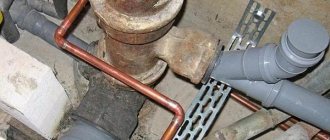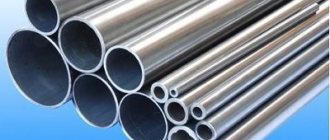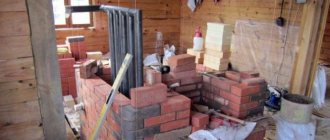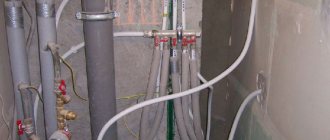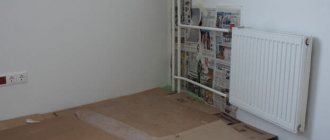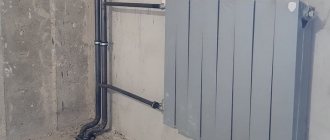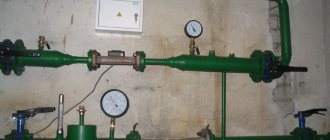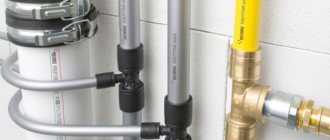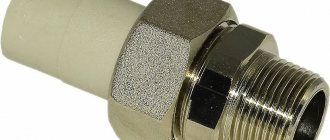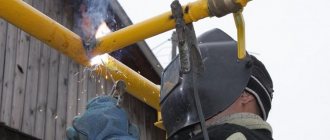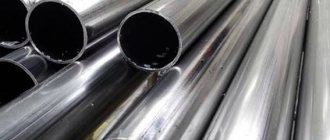Production technology and scope of use
For the production of corrugated pipes from stainless steel, a special one is used, in which the content of chromium and nickel is increased. It is the combination of these elements in the steel that provides it with exceptional corrosion resistance.
Noteworthy is the technology for the production of corrugated stainless steel pipes, which consists of several stages:
- forming a pipe from stainless steel strip;
- connecting the edges of a rolled workpiece, performed using;
- checking the quality of the completed weld, for which a special laser installation is used;
- converting the resulting smooth steel pipe into a corrugated one, for which it is passed through a system of shafts of different diameters;
- heat treatment of the pipe (as a result it becomes annealed and therefore flexible);
- cutting the pipe into products of the required length;
- Compact rolling into coils.
A mandatory procedure after completing all technological operations is quality control of the finished product. At this stage, it is tested under pressure: it is placed in a liquid medium and monitored for the presence of microcracks in their walls.
Homemade heating radiator made from corrugated pipes
All the advantages of corrugated pipes made of stainless steel were fully appreciated by specialists in the construction industry, where these products are most actively used. Thanks to corrugated pipes, it is possible to install serviced communications for various purposes (electrical wiring, plumbing and communications for gas supply, underfloor heating systems, elements of climate systems and security systems). If previously, to repair such communications, it was necessary to chisel and then restore the walls, then when using corrugated pipe rolling, the need for such labor-intensive procedures does not arise. Corrugated pipes are no less successfully used as chimneys, elements of gas communications, ventilation, air conditioning and heating systems.
In housing and communal services, corrugated stainless steel pipes, which are connected using special fittings, are also widely used. With their help, they reconstruct and repair old utility networks, and install new communications that are more reliable and durable. The strength of steel and flexibility, comparable to the mobility of rubber products, as well as the reliability of the fittings used, have made corrugated stainless steel pipes an indispensable element of equipment for enterprises operating in various industries: chemical, food, medical, agricultural, etc.
Water heated floors made of flexible stainless pipes
Criteria for selecting communications and components
Corrugated stainless steel pipe for heating systems is selected based primarily on the diameter of the communications, which is included in the plan. With correctly selected values of this parameter, you can obtain an effective system with high throughput. It should be noted that the cross-section of the pipes must be correlated with the power of the equipment.
Additionally, attention is paid to the steel grade
It is important to consider the manufacturing technology of products. For example, there are flexible communications made of annealed and unannealed steel
The difference between them lies in the operating conditions. For example, annealed pipes are good for installing heating systems. It is recommended to use brass fittings as connecting elements
For example, there are flexible communications made of annealed and unannealed steel. The difference between them lies in the operating conditions. For example, annealed pipes are good for installing heating systems. It is recommended to use brass fittings as connecting elements.
Review of manufacturers and product prices
There are several popular brands, including Neptun. The product range includes annealed and unannealed products, as well as a wide range of fittings. If a corrugated pipe for heating systems is being considered, the price will depend on its cross-section. For example, a product with the smallest diameter of 15 mm costs on average 110 rubles/m.
As an alternative, you can choose products from the Lavita brand. The cost of communications with a diameter of 8 mm will be higher - 150 rubles / m, which is determined by the grade of steel. In the assortment of this manufacturer you can also find fittings for any requirements.
Recommendations from experts
The pricing of flexible products is simultaneously influenced by three factors: steel grade, product cross-section, manufacturing method. If a small-diameter pipe from one manufacturer costs less, it means that a different grade of steel was used in its manufacture
Therefore, these parameters should be paid attention to first.
Accordingly, this type of communication is preferable, especially when it comes to installing a heating system. Since in this case significant loads will be exerted in two directions: temperature and pressure.
Advantages and disadvantages
The growing popularity of stainless steel corrugation is determined by a number of its undoubted advantages:
- Corrugated pipe is extremely flexible. The pipeline can be given any shape during installation, without the use of special skills or tools. Bending does not change the cross-section diameter, does not cause the formation of microcracks or thinning of the walls. The only thing worth remembering is that the minimum bending diameter should be equal to three diameters of the pipe itself. Thus, a standard corrugation with a diameter of 15 mm can be bent to a diameter of 45 mm without any problems.
- The corrugation is resistant to changes in pressure (the declared upper level is 50 atmospheres) and temperature (operating range from -50 to +110 degrees). The upper and lower temperature limits relate rather to the capabilities of silicone or fluoroplastic sealing rings, while the corrugated pipe itself can easily withstand temperatures up to +800 degrees.
- Stainless steel is chemically inactive, which eliminates the possibility of corrosion. Compared to conventional steel, the service life of the product can be increased several times.
- Ease of installation is another important advantage. The pipeline sections are connected using brass fittings with O-rings. Repairing the system will also not be particularly difficult. On average, the use of corrugation allows you to reduce the time for installing a water supply or heating system by 2-3 times.
- Corrugated pipe is not afraid of fungus, rodents, mold, and also easily withstands repeated transitions through the freezing point of the carrier.
- The high reliability of the material allows you to hide the pipeline in a concrete screed or in a layer of plaster.
- Despite its high strength, the product is easily cut using an ordinary hacksaw, grinder or pipe cutter.
We recommend that you read: Using metal corrugation for cable wiring
Of course, like any other material, a stainless corrugated pipe cannot consist of only advantages. There are also some disadvantages, but how significant they are in a particular case is up to each owner to decide for himself:
- Difficult to care for. With long-term use, dirt and dust will accumulate in the metal folds of the surface, which is unlikely to be removed with an ordinary damp cloth. To clean the corrugation you will have to use a stiff brush. However, you can solve the problem differently - simply hide the corrugated pipes in protective covers or boxes.
- Weak impact resistance. In those places where there is a high probability of strong mechanical impacts, the corrugation should also be protected with a special casing.
- Even the most reliable fittings will require periodic maintenance - visual inspection and, if necessary, replacement of o-rings.
- Vulnerability to some chemicals. In combination with the good electrical conductivity of the material, this can lead to chemical or electrochemical corrosion.
- Aesthetic component. Manufacturers of corrugated pipes quite rightly give priority to the functionality of their products rather than their attractiveness. The disadvantage is easily eliminated by concealing the corrugation.
- High thermal conductivity of the material. Makes corrugated pipes not so effective in heating systems (some even use corrugated pipes as a radiator). The problem can be solved by using thermal insulation materials.
Corrugated stainless steel pipe installation
When installing corrugated pipes, there are some nuances that you should know about so that they do not become an unpleasant surprise. As is the case with most bendable building materials, you should not abuse this quality - repeated bends over time are guaranteed to lead to the fact that the corrugated stainless steel heating pipe will be deformed.
It would be much better to bend the pipe to the desired shape and not return to it.
Installing corrugated metal pipes is very similar to conventional pipe installation using fittings. The whole difference lies in the absence of a fitting in the fitting for a corrugated pipe, and crimping is carried out due to the gasket. In any case, after installation a test run must be performed to ensure that there are no leaks.
Corrugated stainless steel pipe for heating is an excellent solution for arranging a heating system. To achieve maximum effect, it is necessary to correctly select materials and carry out high-quality installation work. The resulting heating system will perform its functions properly for many years.
In addition to very good performance characteristics, this material is attractive for the quick and easy assembly of pipelines. All you need is fittings and a wrench. Connections to all heating devices are made using them. Select the required type (angle, tee, cross, etc.) and start connecting.
Use a pipe cutter to cut a piece to the required length. The cut must be strictly perpendicular to the pipe. The edges are smooth without burrs or irregularities. Check that the fitting is complete and fold it. Insert the cut piece into it and tighten the nut. If necessary, tighten it a little with a wrench. That's the whole installation.
Complete set of fittings for stainless steel corrugated pipes. The transition from a regular pipe to a corrugated one occurs in a similar way: first, attach the appropriate fitting to the riser or branch, and then insert a corrugated stainless steel into its other end and tighten the ring. And no special adapters are needed.
The only thing you need to consider when installing corrugated stainless steel is that it is still flexible. Therefore, install fasteners more often than when laying conventional pipe shapes.
This will have little effect on the cost - one fastener costs ten or two rubles, depending on the company, and even if you install them twice as often, the maximum you will face is an overrun of 200-300 rubles with an average length of the heating line.
Installation of fittings
To work with stainless steel pipes, in addition to fittings, you will need a set of tools:
- pipe cutter - without it it is difficult to evenly cut a corrugated pipe, and the reliability of the future assembly depends on the accuracy of the cut;
- installation tool corresponding to the type of connection of the fitting: welding machine for welded shaped elements, a tightening or regular adjustable wrench for crimping, press pliers for crimping;
- knife - it is necessary if the pipes are covered with a protective film.
Having prepared the necessary tools, perform the work in the following order:
- The necessary measurements are taken and the corrugated pipes are cut into pieces of the required length with a small margin.
- Clean and polish the cut. If there is a protective film, cut it 1-2 cm from the edge.
- Clean and degrease the fitting and its auxiliary parts.
- If a welded fitting is used, install it flush with the end of the pipe, fix and solder it, making sure that there are no distortions. This completes the execution of the unit; all that remains is to connect the elements of the pipe network in the same way to the remaining branch pipes of the fitting.
- When using crimp and press fittings, you must first remove the fixing elements: the crimp nut or press ring.
- A nut or ring is placed on the end of the pipe and moved along the pipe from the edge a few centimeters.
- If the corrugation does not have its own retaining ring, insert such a ring into the end of the pipe so that its cut rests against the stopper.
- Remove the sealing ring gasket from the fitting and put it on the pipe so that the edges of the retaining ring and spacer ring coincide.
- Install the fitting body close to the cut of the corrugated hose and move the fixing element towards the body.
- Complete the fixation. If using a compression fitting, tighten the compression nut until it contacts the body. If a press fitting is used, press the ring using press pliers.
We recommend that you read: Polypropylene couplings for creating various types of connections in pipelines
Some manufacturers produce crimp and press fittings in kits that do not require disassembly - this is usually indicated in the product instructions. For such shaped elements, it is enough to loosen the nut by unscrewing it ⅔ of the length of the threaded pipe, or move the press ring the same distance from the body. Then a section of pipe is inserted into the undisassembled fitting until it stops, after which the fixing part is returned to its place where it is crimped or crimped.
Features of chimneys made of corrugated pipes
Application area
Repair of curved brick chimneys
Corrugated steel chimneys are designed to complete heating equipment operating on liquid, gaseous and solid fuels, and can be used with almost any type of boilers, boilers, water heaters and fireplaces, as they have good tightness and heat resistance.
The installation of such a chimney has a positive effect on the operation of heating boilers.
Corrugated stainless steel pipes can be used for the device:
- internal chimneys;
- external chimneys;
- adapters connecting the outlet pipe of the heating device to the main chimney;
- as well as for lining (repairing) brick chimneys with bends.
Clamp for attaching the corrugation to the outlet pipe
Chimney design
Steel corrugated chimneys are made in the form of cylindrical pipes made of individual corrugated strips twisted in a spiral with a thickness of 0.12 mm to 1 mm.
The strips are connected around the circumference with a continuous interlocking seam, which ensures tightness, flexibility of the chimney and its ability to compress and stretch to a certain length. This may be necessary during installation, for example, to attach a pipe to the boiler outlet.
Such pipes have different cross-sectional sizes, so they are easy to match to any outlet pipe.
No welding is required to connect corrugated steel pipes; they are fastened together with clamps while simultaneously attaching thermal insulation. This installation method is very convenient, since if necessary, the corrugated chimney will be easy to disassemble to clean it of soot, and then reinstall it in place.
Advantages and disadvantages
Corrugated pipes have a lot of advantages, which are often decisive when choosing a chimney.
These primarily include:
- Flexibility and elasticity. The design allows the corrugated pipe to be bent at almost any angle, which is very convenient when the chimney needs to create a slope, for example, to bypass ceiling beams.
- Possibility of installation without the use of expensive components - corners, adapters, bends, etc. The corrugated pipe for the chimney will bend in the direction you need without compromising its integrity.
Scope of application
The excellent performance qualities of corrugated pipes allow it to be used equally effectively in a variety of areas of the national economy:
- industry;
- agricultural enterprises;
- food production;
- chemical and pharmacological enterprises.
But corrugated stainless steel has won true popular love thanks to the ability to quickly and efficiently install any pipeline in an apartment or private house. The flexibility and versatility of corrugated materials are especially valuable in the cramped conditions of city apartments, where literally every centimeter of space can count.
We recommend that you read: Types of chimneys for stoves with a long-burning system and which one is better to choose
There are often cases when communications have to be completely redone due to the fact that a few millimeters of pipe were missing during installation. A flexible corrugated pipe can always be laid in such a way that its length is exactly as long as necessary.
Corrugation is produced in standard coils of 50 meters, which makes it easy to install even the largest structures. If necessary, you can order pipes of any size and length from the manufacturer.
Note! The scope of application of corrugated pipes is not limited to water supply or heating systems. A hollow and flexible steel pipe will serve as excellent protection against moisture, rodents and mechanical damage for electrical cables.
Corrugated HDPE pipes
Such pipes are indispensable in an office, country cottage or city apartment. They are used for wiring drainage systems and high-quality cable protection. Corrugated HDPE pipes are tubular channels made on a plastic base. They are extremely flexible, so they can be used to improve and complement older systems.
Corrugated pipes are used specifically for single installation, but it is possible to use an open, hidden or semi-hidden method.
Main technical parameters:
- Wide temperature range - from forty degrees with a minus sign to forty degrees with a plus sign, at which installation can be carried out
- High degree of bending - 360 degrees
- When designing devices that serve as retracting elements, it is necessary to use a broach made of second class steel wire
- From the date of shipment of pipes from the manufacturing plant, the shelf life is at least two years
Types and characteristics of corrugated pipes
There are two main types: single-layer and double-layer corrugated pipes. Double-layer pipes contain an outer and an inner layer. The outer layer is a hard corrugated surface, the inner layer is a thin and smooth surface. The layers are connected by special joints. The main property of double-layer corrugated pipes is their high resistance to deformation. The corrugation provides strength and protection to the polyethylene material contained in the inner layer.
Advantages of corrugated pipes:
- Affordable price
- Variability when laying: closed or open method
- Easy installation, no need to use special equipment or tools
- Durability and long service life

